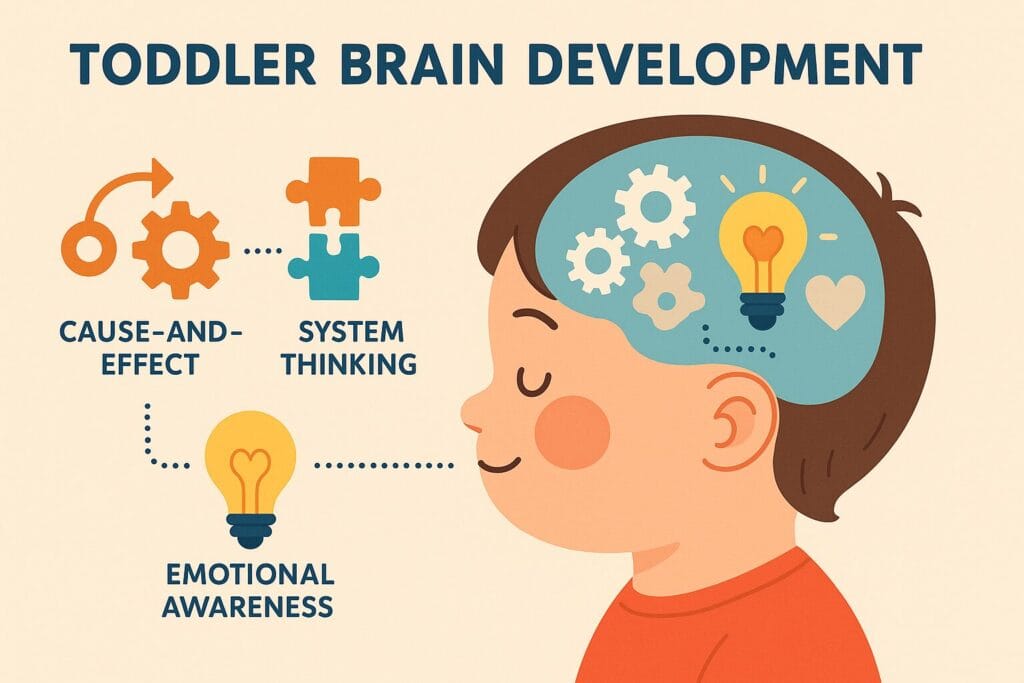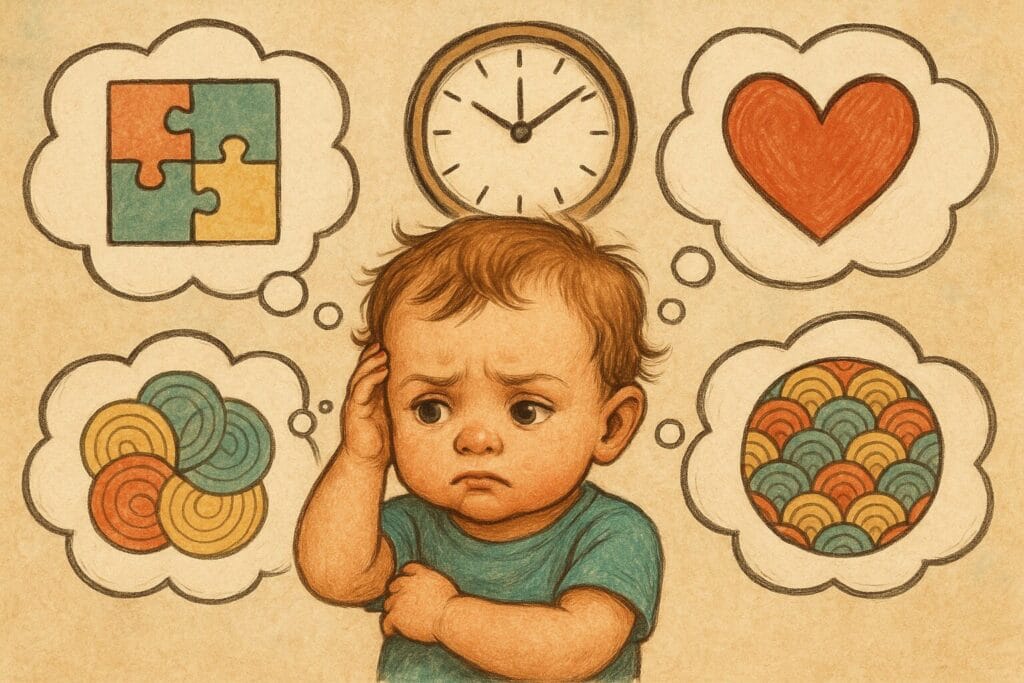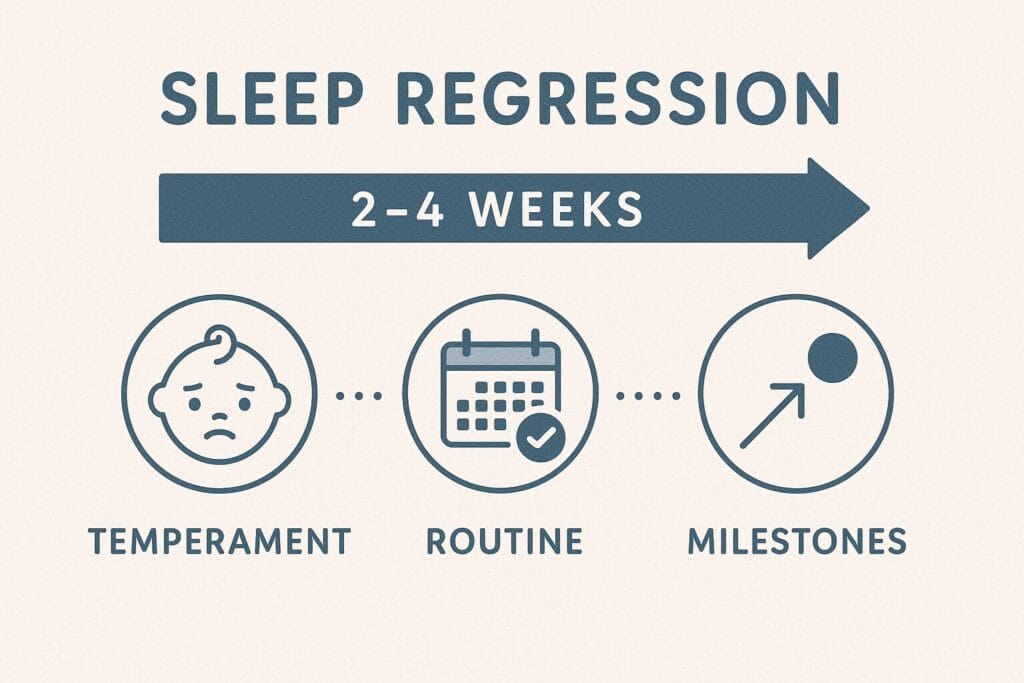If your once-easy sleeper is suddenly skipping naps, waking up at odd hours, or clinging to you at bedtime like never before, you’re not going crazy. Something is going on. That sudden sleep chaos between 17 and 20 months? Yep, it’s real—and honestly, it’s exhausting.
For many families, this challenging phase has a name: Leap 10 sleep regression.
In this post, we’ll break down what Leap 10 is, why it messes with your toddler’s sleep, and how you can get through it without totally losing your mind. We’ll walk you through how this leap affects your toddler’s brain, why it disrupts sleep, what signs to watch for, and, most importantly, how to handle it all while keeping your sanity intact.
Whether you’re in the thick of it right now or just getting ready, this guide is here to bring you clarity, a little comfort, and real-life strategies to help you and your toddler get back to better sleep and restful nights. Because when your toddler’s world turns upside down, knowing what’s going on can make all the difference.
Table of Contents
What Is Leap 10? (The Wonder Weeks Framework Explained)
Understanding Leap 10
According to The Wonder Weeks framework—a popular developmental model based on decades of research—Leap 10 is the final major mental leap in a toddler’s early growth. It typically occurs between 17 and 20 months and marks a transformative shift in how your child perceives and processes the world around them.
During this leap, toddlers begin to grasp complex systems: they start connecting patterns, understanding cause and effect, and recognising how their actions influence outcomes. This newfound cognitive ability brings rapid growth, but also emotional upheaval.
You may notice your child testing boundaries, resisting routines they previously accepted, or becoming more emotionally reactive. That’s because Leap 10 is also a period of intense emotional development—a time when toddlers crave independence but still need constant reassurance. They’re learning how to navigate social rules, express preferences, and build deeper connections.
This rapid shift in brain activity and emotional maturity explains why Leap 10 sleep regression is so ordinary: your toddler’s mind is too busy to rest easily.
What Is Sleep Regression?
Why Toddlers Experience Sleep Regressions

Sleep regression refers to a sudden change in a toddler’s sleep habits, often turning a previously sound sleeper into a restless and unpredictable one. This can involve frequent night wakings, skipped naps, bedtime resistance, or early morning wake-ups, often catching parents off guard.
These disruptions usually coincide with periods of rapid mental or physical growth. As your toddler reaches new developmental milestones—learning to walk, talk, or process more complex thoughts—their brain becomes overstimulated, and their sleep patterns suffer as a result.
Common stages when toddler sleep regressions occur include around 4, 8, 12, 18 months and 2 year. The 10-month sleep regression is one of the most noticeable, due to the advanced cognitive and emotional developments that occur.
In short, sleep regressions can be frustrating, but they are a regular part of development. They’re a sign that your child is growing fast. And with the right strategies, they’re also something you can get through.
Signs of Leap 10 Sleep Regression

Wondering if your toddler is going through the Leap 10 sleep regression? While every child is different, several telltale signs typically show up during this stage:
- Bedtime resistance
Your toddler suddenly fights sleep, stalling with extra requests or refusing their usual bedtime routine altogether. - Night wakings
Children who previously slept through the night may begin waking multiple times and struggle to fall back asleep. - Early wake-ups
Mornings may start far earlier than usual—sometimes before 6 a.m.—with your child wide awake and ready to play. - Skipped or short naps
Naps become inconsistent or disappear entirely, leading to overtiredness and cranky afternoons. - Increased clinginess
Separation anxiety peaks during this leap, making your toddler more attached and harder to settle independently. - Emotional outbursts
As their cognitive and emotional world expands, toddlers may struggle with regulation, resulting in frequent tantrums or mood swings.
If you’re seeing a combination of these behaviours, it’s likely your toddler is navigating Leap 10, and their sleep is just along for the ride.
Why Leap 10 Triggers Sleep Disruption

Cognitive + Emotional Overload
The reason the Leap 10 sleep regression feels so intense is that your toddler’s brain is undergoing a complete system upgrade. This isn’t just a growth spurt—it’s a full-on developmental transformation.
- Brain in overdrive
During Leap 10, toddlers begin to understand complex ideas like routines, relationships, and cause and effect. This “systems thinking” can make it harder for them to wind down at night—their mind is too busy to rest. - Increased independence
With new cognitive skills comes a desire for autonomy. Your toddler may suddenly push back on sleep routines they once accepted, asserting control in ways that often lead to power struggles at bedtime. - Rising separation anxiety
As their emotional intelligence grows, so does their awareness of your absence. Bedtime can trigger anxiety, leading to more frequent night wakings and a stronger need for reassurance.
These overlapping mental and emotional changes create the perfect storm for sleep disruption. Understanding what’s driving the behaviour can help you respond with more patience and better tools.
How Long Does Leap 10 Sleep Regression Last?

One of the most common questions parents ask is, “How long will this last?” The good news is that the Leap 10 sleep regression is temporary. In most cases, the regression lasts between 2 and 4 weeks, though the exact duration can vary based on several factors.
Influencing factors include:
- Child temperament
More sensitive or spirited toddlers may take longer to adjust, while others may go through the process with minimal disruption. - Consistency in routines
Children thrive on predictability. A steady bedtime and nap routine can help shorten the length of the sleep regression by providing a sense of safety and rhythm. - Concurrent milestones
If your child is also learning to walk, teething, or experiencing changes in their environment, the impact of the Leap 10 sleep regression may be more pronounced and prolonged.
While it may feel endless in the moment, rest assured that with patience and structure, your toddler’s sleep will stabilise as they work through this critical developmental leap.
Strategies to Manage Leap 10 Sleep Regression
📌 Stick to Routines
One of the most effective ways to manage the Leap 10 sleep regression is by maintaining a consistent daily routine. At a time when your toddler’s cognitive world is rapidly expanding, predictability becomes a stabilising force.
Toddlers thrive on knowing what comes next. A stable bedtime routine—think bath, pyjamas, story, bed—helps create a sense of control and emotional safety. This familiarity can ease resistance and reduce the mental overstimulation that often accompanies sleep regression during developmental leaps, such as Leap 10.
Even when sleep is disrupted, avoid making drastic changes to your bedtime or nap times. Instead, focus on keeping the structure intact so your toddler can settle into a rhythm again as the regression fades.
The goal isn’t perfection—it’s consistency. A familiar routine helps communicate: “You’re safe. You’re loved. It’s time to rest.” And that message is powerful during the chaos of Leap 10 sleep regression.
💞 Offer Comfort and Reassurance
During the Leap 10 sleep regression, your toddler may become unusually clingy or emotional, especially at night. This is entirely normal. Their world is shifting rapidly, and they need extra support to feel safe and grounded.
When your child wakes in the middle of the night, respond calmly and consistently. Gentle reassurance—whether through your voice, a quiet back rub, or simply being present—can help them settle without reinforcing fear or frustration.
Consider introducing transitional objects, like a favourite stuffed animal or blanket, that stay in the crib. A soft nightlight can also ease separation anxiety, giving your toddler a sense of control and comfort in the dark.
This stage isn’t about enforcing independence—it’s about building trust. The emotional reassurance you offer now can ease the intensity of the Leap 10 sleep regression and support smoother nights in the weeks ahead.
👶 Support Independence
One of the defining traits of the Leap 10 sleep regression is your toddler’s growing desire for autonomy. As their cognitive skills sharpen, they begin to assert control, and bedtime is often their battleground of choice.
Rather than fight it, lean into this need for independence in a structured way. Offer small, age-appropriate choices during the bedtime routine—such as which pajamas to wear, which book to read, or which stuffed animal to bring to bed. These decisions give your toddler a sense of ownership without compromising the routine itself.
Beyond bedtime, encourage independence in other parts of the day: let them help clean up toys, pick a snack, or choose their shoes. This builds confidence and helps reduce power struggles in the future.
Supporting autonomy in healthy, controlled ways can reduce resistance and tantrums—two major hurdles in the Leap 10 sleep regression. When toddlers feel respected and empowered, they’re more likely to cooperate, even when emotions run high.
🧠 Encourage Daytime Skill Practice
The brain behind the Leap 10 sleep regression is working overtime—not just at night, but all day long. Your toddler is learning to understand systems, routines, and how their actions affect outcomes. That’s a lot to process for such a little human.
One powerful way to ease the tension is to give your child plenty of opportunities to practice new skills during the day. Whether it’s stacking blocks, climbing at the park, sorting shapes, or mimicking routines, these activities provide essential mental and physical outlets.
When toddlers don’t get to explore their evolving abilities, the energy they’ve stored often surfaces at the worst possible time: bedtime. By allowing that energy to be expressed during waking hours, you reduce the chance of it spilling over into nighttime restlessness.
Encouraging cognitive and motor development through play isn’t just great for learning—it’s a strategic way to soften the impact of Leap 10 sleep regression and support more restful sleep.
⏳ Practice Patience and Perspective
Perhaps the most essential tool you can bring to the Leap 10 sleep regression is perspective. This phase, while frustrating and exhausting, is a regular part of toddler development—and more importantly, it’s temporary.
Your child isn’t regressing out of nowhere. They’re growing—fast—and struggling to integrate all the new cognitive and emotional information flooding their world. As challenging as this leap may be, it signals that their brain is advancing in meaningful ways.
The best thing you can do? Stay consistent with your routines, reinforce emotional safety, and remind yourself that this phase will pass. Respond with calm and empathy, even when sleep feels elusive and emotions are high.
Every disrupted bedtime and night waking is part of your toddler’s journey toward greater independence and understanding. By meeting them with patience now, you’re building the trust that leads to smoother nights long after the Leap 10 sleep regression is over.
When to Seek Help

While the Leap 10 sleep regression is a regular part of toddler development, there are times when sleep disruptions may signal something more serious.
If your toddler’s sleep difficulties persist for more than 6 weeks with little to no improvement, it may be time to explore other possibilities. Extended regressions aren’t typical and can lead to cumulative sleep deprivation for both the child and caregiver.
You should also consider consulting a paediatrician or sleep specialist if you notice any of the following:
- Ongoing health concerns, such as symptoms of sleep apnea (snoring, gasping, or pauses in breathing), chronic ear infections, or suspected teething pain disrupting rest.
- Constant irritability or extreme mood swings that seem out of proportion, especially if paired with developmental regression, like losing previously mastered language or motor skills.
- Parental burnout, anxiety, or exhaustion. Your well-being matters too, and getting professional guidance can lighten the load.
Remember: seeking help doesn’t mean you’re doing something wrong. It means you’re doing exactly what your child needs during—and beyond—the challenges of Leap 10 sleep regression.
Resources & Further Reading

For parents seeking more profound insight into the Leap 10 sleep regression, these expert-approved resources provide a mix of developmental theory, clinical context, and practical parenting strategies:
- The Wonder Weeks: Leap 10 Overview
A foundational guide to the Wonder Weeks framework—this resource explains the cognitive and emotional milestones of Leap 10 in detail, helping you understand what your toddler is going through and why it affects sleep. - Bella Luna Family
Focused on parenting through developmental changes, this article offers real-world strategies to navigate Leap 10 sleep regression with calm and confidence. - Medical News Today
A trusted medical source that breaks down the different stages of sleep regression, including how developmental leaps contribute to disrupted rest. - Aumio
A science-backed platform that explores mindfulness and sleep in early childhood—great for parents interested in emotional regulation techniques and structured sleep support. - Longdom Sleep Regression Report
A deeper academic dive into the biological and behavioural causes of sleep regressions, with a focus on intervention strategies and long-term outcomes.
Frequently Asked Questions: Leap 10 Sleep Regression
What is Leap 10 sleep regression?
Leap 10 sleep regression refers to sleep disturbances that occur around 17 to 20 months of age, coinciding with a significant developmental phase known as Leap 10. During this time, toddlers experience rapid cognitive and emotional growth, which can temporarily disrupt their sleep patterns.
When does Leap 10 sleep regression typically occur?
This regression usually manifests between 17 and 20 months of age, aligning with the developmental changes outlined in the Wonder Weeks framework.
When does Leap 10 sleep regression typically Last?
The duration varies for each child, but it typically lasts between 2 and 4 weeks. Factors such as the child’s temperament, consistency in routines, and concurrent developmental milestones can influence the length and intensity of the regression.
What are the common signs of Leap 10 sleep regression?
Parents may notice increased resistance to naps and bedtime, frequent nighttime wakings, shorter or skipped naps, early morning wake-ups, increased clinginess, and more daytime tantrums or fussiness.
Why does Leap 10 trigger sleep disruptions?
During Leap 10, toddlers develop a deeper understanding of systems, relationships, and the consequences of their actions. This cognitive leap can lead to increased independence and separation anxiety, making it challenging for them to settle down and sleep peacefully.
How can I help my toddler through Leap 10 sleep regression?
Maintaining consistent routines, offering comfort and reassurance during night wakings, encouraging independence through choices, providing opportunities for daytime skill practice, and practising patience can all help manage this phase effectively.
Is it normal for my toddler to be more clingy during this time?
Yes, increased clinginess is a common behaviour during Leap 10. As toddlers become more aware of their surroundings and relationships, they may seek additional comfort and reassurance from caregivers.
Should I adjust my toddler’s sleep schedule during Leap 10?
While it’s essential to remain flexible, maintaining a consistent sleep schedule can provide a sense of security and help your toddler navigate this regression more smoothly.
When should I seek professional help for sleep issues during Leap 10?
If sleep disruptions persist for more than 6 weeks or if you notice signs of developmental regression, constant irritability, or suspect health issues like sleep apnea, it’s advisable to consult a paediatrician or sleep specialist.
Conclusion
The Leap 10 sleep regression can feel like an exhausting curveball in your toddler’s development, but it’s also a clear sign of remarkable mental and emotional growth. As your child begins to understand systems, independence, and relationships, their sleep can become temporarily disrupted, often leaving everyone in the household feeling unbalanced.
The key is to stay consistent, supportive, and patient. Recognise the signs, use calming strategies, and lean on routines that bring a sense of security. Most importantly, remember this: Leap 10 is a phase, not a problem. It will pass.
By staying grounded through this milestone, you’re not just managing sleepless nights—you’re helping your child build the confidence and emotional resilience they’ll carry forward long after the leap ends.
You’ve got this. 🌙



